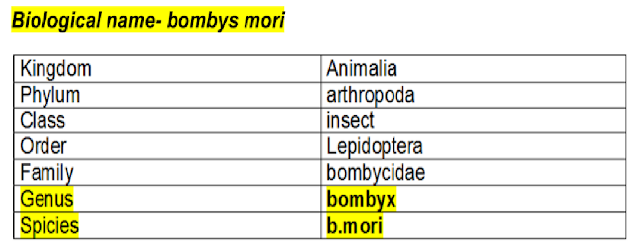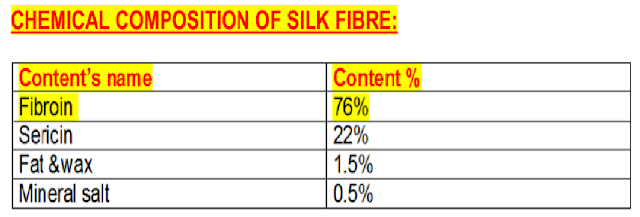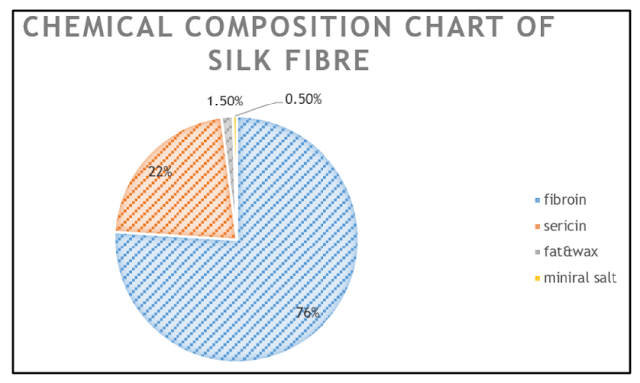SILK FIBRE:
The "silk" fibre is still a symbol of luxury. It is a "natural" fibre. It is obtained from insects. The silk fibre has excellent fibre characteristics. It shows a very high degree of lustre, soft feel and touch, drape, and elongation property. Since the production of silk fibre requires bulk men power, therefore it also helps to generate big employment in rural and trivial regions. Its natural sheen, moisture-absorbing capability, dyeing affinity, and low specific gravity make it " queen " among all fibres. The silk is a very "expensive" fibre. It contributes only 0.2 % of world textile production. The silk fibre consists of proteins. Near about 40 countries are engaged in the production of silk fibre. Asia ( China and India) is the biggest partner of silk production in the world. China and Indian silk are considered as the best quality silk fibre in the world. China is the biggest silk-producing country. India holds the second position in silk production.
HISTORY OF SILK FIBRE:
The world is using silk as textile fibre for a very long time ago. Chinese were aware of the use of silk filaments as textile fibre in 2700 BC. They dominated for near about 1000 years in silk production. The got succeeded to maintain their dominance in the field of silk production. They kept a monopoly on silk production for one thousand years. Japanese learned the use of silk in 300 CE. The Arabian knew about silk at the same time. The production of silk got spread around the world. The monopoly of the Chinese got broken. As the technique got developed and the spinning wheel came into existence. The silk yarn production became developed in most of the countries.
The industrial revolution completely changed the European silk industry. Due to technology development, the production cost of silk yarn became cheaper. After all technological innovations, the silk yarn is still expensive textile.
BIOLOGICAL CLASSIFICATION OF SILK
WORM
CHEMICAL COMPOSITION OF SILK FIBRE:
Chemical composition of silk fibre is given below:
Chemical composition chart of silk fibre:
CHEMICAL STRUCTURE (FORMULA) OF SILK FIBRE:
Silk fibre obtained from silkworm is composed of mainly two type of proteins. One is sericin and other is fibroin. Fibroin is the structural centre of the silk, and sericin is the sticky material surrounding it. “Fibroin mainly composites of the amino acids Gly-Ser-Gly-Ala-Gly-Ala and forms beta-pleated sheets, β-keratin”.
R = H, glycine; R = CH3, alanine; R = CH2OH, serine
Hydrogen bonds form between chains and side chains from above and below the plane of the hydrogen bond network.
( fibroin protein in silk)
SILK FIBRES PRODUCTION:
Cultivation of the silkworm is called sericulture”. Many insects produce silk, but only the filament produced by Bombyx mori, the mulberry silk moth, and a few others in the same genus, are used by the commercial silk industry. Following stages come in production of silk fibre:
Hatching the eggs:
The first stage of silk production is the laying of silkworm eggs, The female deposits 300 to 400 eggs at a time. A one square foot area gets covered with the eggs of near about 100 female's eggs. The eggs are tested for any disease too. The size of each egg looks like a pinhead. The females are get died after egg deposition. The male moth also gets died after some time without damaging these eggs. A shoebox is needed to keep the silkworms. A place is decided in the room where sunlight does not hit directly but a warmness is getting felt. Now the shoeboxes are placed at the chosen place. The top of the box is covered with plastic sheets. These plastic covers help to reduce the evaporation of moisture of leaves without developing a humid atmosphere inside the shoeboxes. These eggs are lubricated for approximately one week. The eggs of silkworm are scattered all over the boxes. The larvae are developed from these eggs.
Feeding of the caterpillar:
The larvae are placed on the leaves. The new laevaes are rotated up every day. The fresh mulberry leaves are fed to them.
The eggs get developed. Now, these larvae get changed into the caterpillar. These caterpillars use mulberry leaves as food for approximately one month. The caterpillar moults through four-time skin. The weight of the caterpillar gets increased by many times.
Cocoon spinning:
The silkworm begins to attach themselves to a compartmented frame to spin a silk cocoon for a few days. “This period is termed pupating”. The silkworms has a pair of specially modified salivary glands called sericteries. The caterpillar uses these glands to produce the fibroin. A clear, viscous, proteinaceous fluid is forced through spinnerets( mouth organ) by the caterpillar. The liquid secretions from the two large glands in the insect come out from the spinneret, a single exit tube in the head. “The diameter of the spinneret determines the fineness of the silk filament, The secretions get hardened on exposure to the air and form twin filaments composed of fibroin, a protein material. The second pair of glands secrete a gummy binding fluid called sericin which bonds the two filaments together. The silkworm spins a 1-kilometer filament approximately. The spinning process gets continued until the development of the pupa. This cocoon works like a protection cover for the pupa to be developed just after the end of the spinning. This spinning process is ended completely almost within three days. Now cocoon is fully developed. This cocoon looks like a peanut shape and size. When the cocoon gets developed fully, the pupa is killed with the help of boiling water or steam.
Reeling the Filament:
After killing the pupas present inside the cocoon after boiling or steaming, the filament needs to convert into reel form. The filaments of four to eight cocoons are grouped together as per required yarn fineness. This process is performed with high careness. The hanks Or skeins of yarn are manufactured by the reeling process. A slight twist also provided to the yarn during reeling if needed.
Throwing:
“The process of the conversion of raw silk into a sufficient, strong strand by twisting is called throwing. The silk yarn gets suitable for weaving or knitting Throwing helps to prevent the thread from splitting into its constituent fibres.
Spun silk:
Broken or waste filaments and damaged cocoons are retained, treated to remove the sericin, and combed. This is then processed into yarn, marketed as spun silk, which is inferior in character to the reeled product and much cheaper.
MAJOR SILK PRODUCING COUNTRIES:
The silk fibre is cultivated in more than 40 countries in the world. China and India main share the main silk production in the world. Around 95% of the silk production of the world comes from Asian countries. China is the biggest producer of silk today. India is the second-largest producer of silk in the world. The main silk-producing countries are being given below:
1-China
2- India
3-Japan
4-Brazil
5-Korea
6-Uzbekistan
7-Iran
8-Thailand
9-Vietnam
10-Romania
MAJOR SILK PRODUCING STATES IN INDIA:
India is the second-biggest producer of silk. It is also the largest consumer of silk in the world. It has a strong “tradition and culture-bound domestic market of silk”. In India, mulberry silk is produced mainly in the following states:
1-Karnataka.
2-Andhra Pradesh.
3-Tamil Nadu.
4-Jammu & Kashmir.
5-West Bengal.
The non-mulberry silk is produced in the following states:
1-Jharkhand.
2-Chattisgarh.
3-Orissa.
4-North-eastern states.
PHYSICAL PROPERTIES OF SILK FIBRE:
Tenacity:
The silk fibres has very good strength due to presence of many hydrogen bonds to be formed in a more regular pattern. When it comes into contact of water( wetting conditions) , it gets weakened due to hydrolization of a large numbers of hydrogen bonds present in it by water molecules. Tenacity of silk fibre ranges between 3 to 6 grams/ denier.
Elongation:
Silk fibre shows very good elongation properties. Silk fibre has an elongation at break of 20-25% under standard conditions. It's elongation at break gets increased upto 33% at 100% R.H.
Elasticity:
Silk is considered to be more plastic than elastic fibre. If the silk material is stretched excessively, the silk polymers will slide past each other. This happens due to Betaconfiguration present in the silk polymers. A large number of hydrogen bonds get ruptured due to application of stretching force. Thus the silk behaves like a more plastic nature than elastic.
Handle:
The silk fibres have slightly stiffness in feel due very crystalline polymer. Surface of the silk feels smooth.
Resistance to Abrasion:
Silk fabric possess good abrasion resistance as well as resistance to pilling.
Absorbency:
It has more absorbency than cotton. The moisture regain of silk is 11%. It absorbs moisture more quickly than cotton but it gets dried fairly quickly too.
Specific gravity:
The specific gravity of silk is 1.25( degummed silk) It is lighter than cotton.
Thermal conductivity:
Silk is more sensitive to heat than wool. The silk fibre starts to burn at 175°c ( begins to fuse)
Electrical conductivity:
The silk is a poor conductor of electricity. it has a tendency to form static charge, when it is handled during different kinds of processes like weaving etc. This causes difficulties during processing in dry atmosphere.
Drape:
Silk fibre sows good flexibility. The silk fabric poses good drapping properties.
Exposure to sunlight:
The silk fibre is more sensitive to light than any other natural fibre. When this comes for long time exposure to sunlight, it's colour gets spotted partially. Fabric also gets yellowish due to degradation occurred by sunlight.
CHEMICAL PROPERTIES OF SILK FIBRE:
The chemical properties of silk fibre are given below:
The chemical properties of silk fibre are given below:
Effect of water
When silk fibre is kept in boiled water for a short period of time, it does not show any type of effect of boiled water. Silk fibre tends to loss its strength to some extent when it is kept in boiling water for long time. This strength loss occurs due to hydrolysis action of water. Silk fibre withstands, however, the effect of boiling better than wool.
Effect of acids:
Silk fibre reacts with acids more quickly. Silk fibre is soluble in hot and concentrated sulphuric acid and hydrochloric acid. It gets yellowish when it comes into contact of Nitric acid. It is slightly affected by diluted organic acids at room temperature. The concentrated organic acids dissolve the silk fibres.
Effect of alkalis:
Effect of alkalis:
When silk fibre comes into contact of Alkaline solutions, it begins to swell. It dissolves completely after some time. It is treated with 16%-18% solution of sodium hydroxide at low temperature to creat crepe effect blended fabric having cotton.
Effect of oxidizing agent:
The fibroin present in the silk doesn't get affected badly by hydrogen peroxide solution. The weight loss occurs when it is treated in hydrogen peroxide solution. Chlorine solution affects more badly than Hypochlorite. Low concentration of chlorine solution does damage to fibroin present in the silk.
Finishes given to silk:
Degumming – Removal of silk gum, sericin.
Weighting- Adds weight after degumming.
Scrooping – Treated with organic acids to produce the scroop sound when worn
Calendering – Enhances luster and makes it wrinkle free.
DEGUMMING OF SILK:
The fibroin present in the silk fibre is covered by thin layer of sericin. This sericin present in the silk fibres greatly affects the handle, sheen and texture of the finished goods,. It gets necessary to remove the sericin from the silk fibres. The silk gets more soft, lustrous after removal of sericin. The improved texture is also resulted after sericin removal. This serricin is also known as silk gum.
Thus, we can say that the main objective of the degumming process is to get improved lustre, softness, and texture. “The process of removing the sericin or silk gum from silk fibre is called degumming”.
As mentioned above, the silk gum( sericin) in the silk fibres acts as a protecting cover in it. This layer of sericin is kept unremoved till fabric manufacturing ( weaving) if the fabric is woven with undyed silk. This silk gum is removed during fabric dyeing. If we weave the fabric with yarn dyed silk, it gets necessary to remove the gum in yarn form.
During degumming proces proces, the yarn or fabric is treated with an alkaline ( sodium carbonate) and surfacing agent( sodium lauryl sulphate) .The required chemicals are dissolved in normal water. Some amount of hot water is added to it for proper dissolution of chemicals. This solution is boiled initially, the the temperature is reduced. It remains still hot. Now the yarn or fabric is teated with this solution for 30 minutes. The silk is washed with hot water. Then it is neutralized with citric acid or any other suitable neutralizing agent ( acid).
There almost 15℅ to 25 % weight loss occurs after complete removal of sericin during degumming of silk.
WEIGHTING OF SILK FIBRE:
We know that a huge weight loss occurs during the degumming of silk. This weight loss is recovered again by treating the processed silk with weighting agent. " The process of recovery of weight loss during degumming by using any external weighting agent is called weighting of silk". In this process the processed silk is treated with any suitable silicate solution. The properties of silk like feel, softness, and lustre also get changed up to some extent. Extra dose of weighting agent can be harmful to the silk fabrics.





No comments:
Post a Comment